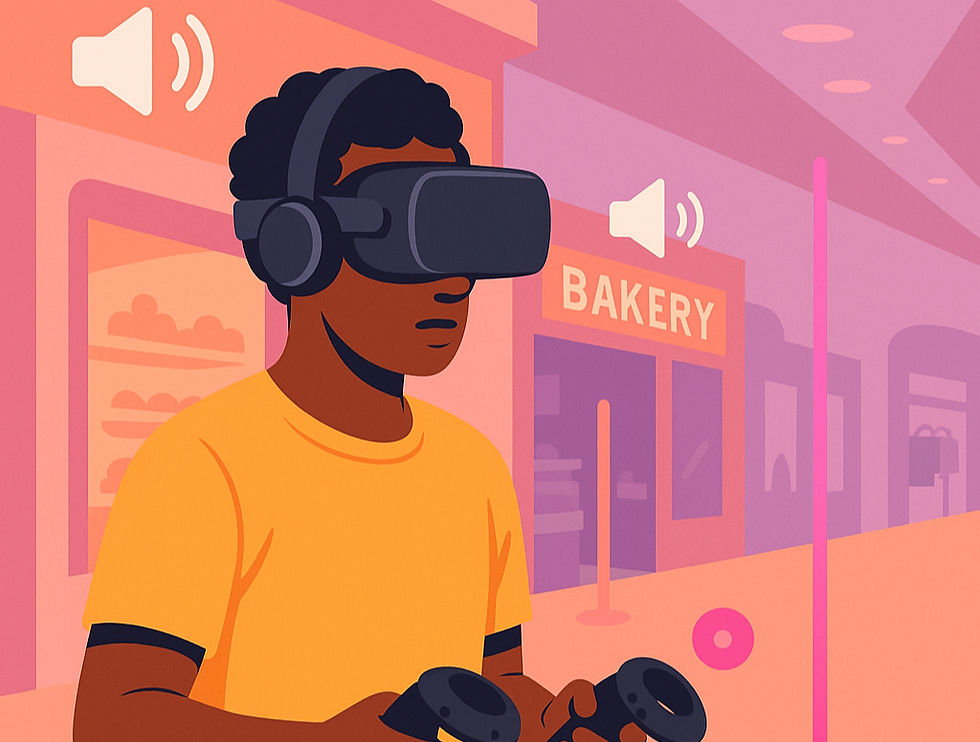Moving Through a Virtual Mall When You Can’t See: What One Study Taught Us
- Nilotpal Biswas
- Jun 25
- 3 min read

Imagine you slip on a VR headset and suddenly you’re inside a busy shopping mall. Now picture navigating that mall without clear vision. How would you locate the bakery? How would you avoid colliding with a wall or other shoppers? To explore this navigation challenge, we look at the research article “Investigating Virtual Reality Locomotion Techniques with Blind People,” which evaluates three straightforward methods that allow blind users to move through virtual spaces using only the standard controllers bundled with today’s headsets.
Three Ways to “Walk” in VR
Arm Swinging: You pump the controllers back and forth as if you’re power-walking, and the virtual world moves with you.
Thumb-stick Walking: You push a joystick forward and glide ahead, similar to using the left stick in a video game.
Point & Teleport: You aim the controller like a laser pointer, press a button, and zip to that spot instantly.
Fourteen blind adults tried all three methods inside a spacious virtual field dotted with walls and different ground textures. The researchers added detailed sound (grass crunches, footstep echoes) and gentle vibrations whenever a wall or obstacle was near.
What Happened
Everyone reached the goals. All three techniques let participants find each checkpoint, and nobody got “stuck” in the environment.
No single winner. Each method had devoted fans and critics. Some loved the physical rhythm of arm swinging; others preferred the familiar joystick; a few adored the speed of teleporting.
Audio and touch cues did the heavy lifting. Footsteps that changed pitch on different surfaces, beeps that pointed toward the next target, and a quick buzz when you brushed a wall were enough for people to orient themselves without sight.
Turning your body matters. Almost everyone naturally rotated their torso toward a sound before moving, even when they could have slid sideways with the joystick.
Why This Is Big News
Many past accessibility studies used special “one-off” gadgets: white-cane controllers or rooms filled with extra cameras. That gear is expensive and rarely leaves the lab. This study shows that, with thoughtful sound design and a bit of vibration, everyday VR hardware can already serve blind users surprisingly well.
Bringing These Lessons Into a Virtual Shopping Mall
A supermarket or fashion store is more cluttered than an open field, but the same principles apply when you want visually impaired shoppers to feel at home in VR.
Give people a choice of movement styles. Long corridors? Teleport gets you there fast. Tight aisles? Arm swinging or slow thumb-stick walking offers fine control. With a simple voice command or the press of a button, the shopper can instantly switch to whichever movement style suits them best at that moment.
Treat sound as the main signage. Each department: produce, clothing, checkout, can have its own looping ambience (fruit market chatter, rustling hangers, cash-register chimes) that grows louder as you approach. Subtle pings every few seconds can guide someone back to their chosen path if they drift off course.
Add gentle vibration near shelves and displays. A short buzz tells you you’re close enough to “touch” a virtual box of cereal. A different pattern might mark price tags or special offers. Touch becomes the new eyesight.
Turn teleport into a “sonar.” Waving the controller like a flashlight and hearing how far the beep echoes gives a quick mental map of aisle length and nearby obstacles, much like body echolocation, but digital.
Expect real-world body turns. Because many blind users twist their torso toward sounds before moving, keep the play area (the real world area) free of tangling cables and let people swivel safely.
Let shoppers tune their speed. Selecting the right speed reduces motion sickness and makes it easier to listen to product descriptions.
Watch, learn, and improve. By anonymously recording details, such as how often shoppers bump a shelf or switch movement styles, you can spot which areas need clearer audio cues or a better shelf layout.
A Final Thought
Making VR truly accessible isn’t just about inventing new gadgets; it’s about refining the layers most of us hardly notice footsteps, distant music, a buzz in the hand so they carry the information that sight normally provides. With smart sound, nuanced vibrations, and flexible controls, a virtual mall can become a place where visually impaired shoppers browse, compare prices, and enjoy the trip just like anyone else.
Reference
Ribeiro, R.A., Gonçalves, I., Piçarra, M., Seixas Pereira, L., Duarte, C., Rodrigues, A. and Guerreiro, J., 2024, May. Investigating virtual reality locomotion techniques with blind people. In Proceedings of the 2024 CHI Conference on Human Factors in Computing Systems (pp. 1-17).



Comments